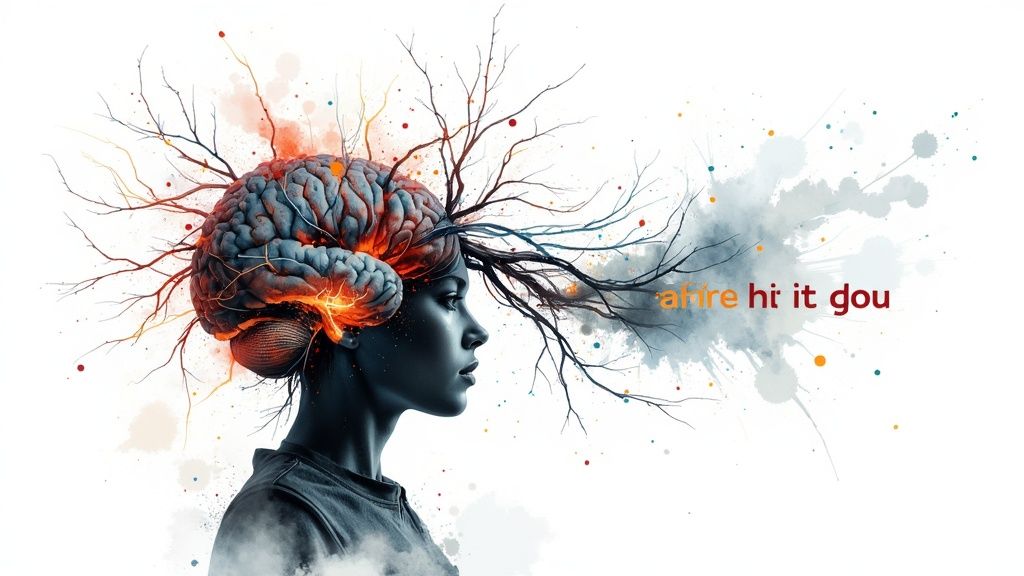Introduction to AI Video Captioning

AI video captioning is making video content more accessible and searchable than ever before. This technology uses artificial intelligence to automatically create captions, converting spoken words into text displayed on screen. This seemingly simple function offers a wealth of advantages for both content creators and their audiences, much like a dedicated transcriptionist working tirelessly behind the scenes. This frees creators to concentrate on their primary skill: crafting engaging video content.
How AI Benefits Video Content
AI-generated captions are not simply a matter of convenience; they are vital for reaching a broader audience. For instance, captions provide essential access for viewers with hearing impairments, ensuring everyone can enjoy and understand the content. Furthermore, captions are beneficial for viewers in noisy environments or those who prefer to watch videos silently. This is especially important in today's world, where mobile consumption of video content is prevalent. This widespread accessibility naturally translates into increased viewership and engagement.
The Impact of AI on Video SEO
Beyond accessibility, AI captions play a significant role in boosting video SEO. Search engines rely heavily on text to understand the content of videos. Accurate captions provide search engines with the information they need for proper indexing and ranking. As an example, if your video focuses on "budget-friendly travel tips," incorporating these keywords in your AI-generated captions will improve search result rankings for related searches. This precise SEO strategy can significantly enhance video visibility and attract a wider viewership. Greater discoverability results in higher engagement and, ultimately, a better return on your video content investment. The efficiency and accuracy of AI in generating these captions is changing the way we create and consume online video content.
How AI Caption Generation Works
The power behind AI video captioning lies in a combination of technologies, primarily Automatic Speech Recognition (ASR) and Natural Language Processing (NLP). Working together, these technologies transform spoken words into accurate, synchronized text. While complex behind the scenes, this process is seamless for the user. Understanding this process helps content creators appreciate the capabilities of AI captioning.
Automatic Speech Recognition (ASR)
ASR is the first step, converting audio into text. It acts like a highly sensitive listener, meticulously transcribing every word from the audio track. This technology utilizes complex algorithms, trained on vast datasets of audio and text, to recognize speech patterns, accents, and even background noise. Recent advancements in deep learning and neural networks have drastically improved the accuracy of ASR. This leads to more reliable AI-generated captions that require minimal manual editing.
Natural Language Processing (NLP)
Once the audio is converted to text, NLP refines the output. Going beyond basic transcription, NLP adds a layer of understanding to the generated text. It identifies the context of spoken words, clarifies words that sound alike but have different meanings, and adds punctuation and formatting to the captions. This crucial step is similar to a meticulous editor reviewing a text for clarity and accuracy. As a result, the final captions are not just accurate but also grammatically sound and readable.
Putting It All Together: Generating AI Captions for Video
The process begins with uploading a video to a platform or processing it through an AI captioning tool. The audio track is extracted and sent to the ASR system, which produces a raw text transcript. NLP algorithms refine this transcript, adding punctuation, correcting errors, and ensuring the captions fit the video's context. The finalized captions are then synchronized with the video's timeline, appearing on screen at the exact moment the corresponding words are spoken. This synchronization is fundamental for an accessible and engaging viewing experience. For example, out-of-sync captions can be distracting and difficult to follow. Precise synchronization connects spoken words with the displayed text, enhancing comprehension and enjoyment. This powerful combination of ASR and NLP has significantly improved video accessibility and simplified the creation of AI captions.
Benefits for Content Creators

AI captions offer content creators a range of advantages that go far beyond simple transcription. This technology is changing how we produce and share video content, increasing its accessibility, engagement, and discoverability. This translates to a stronger online presence and a more substantial impact on the intended audience.
Increased Accessibility and Wider Reach
One key advantage of AI captions is their ability to enhance accessibility. Captions are essential for viewers with hearing impairments, enabling them to understand the content. This inclusivity expands your audience and helps your message connect with a more diverse group. Captions also accommodate viewers who prefer silent viewing, a common preference in public spaces or while commuting. This adaptability increases your content's usability in various situations, broadening its potential reach.
Improved SEO and Discoverability
AI-generated captions contribute significantly to improving video SEO. Search engines rely on text to comprehend video content. By embedding relevant keywords within your captions, you provide valuable context for search algorithms. This enhanced searchability translates to better rankings in search results, increasing your video's visibility. For instance, if your video is about "home gardening techniques," using this phrase and related terms in your captions will make it easier for users searching for gardening advice to find your content. This targeted optimization can greatly increase your video's organic reach. You might be interested in: How videos are good for SEO.
Enhanced User Engagement and Watch Time
Captions not only improve discoverability but also enhance viewer engagement. Studies show captions encourage viewers to watch videos completely. Increased watch time signals value to platforms like YouTube, further improving search rankings and recommendations. Moreover, captions improve clarity, especially for viewers who are not native speakers of the video's language. This clarity enhances the viewing experience and encourages sharing, expanding your reach organically.
Time and Cost Savings
Manually generating captions is a time-intensive and costly process. AI automation frees valuable time and resources, allowing creators to focus on other essential aspects of content production, such as planning, filming, and promotion. This automation also leads to significant cost savings, making professional-quality captions accessible to all creators. This efficiency allows for greater content output in less time, maximizing potential for growth. The combination of these benefits makes AI video captioning invaluable for any content creator looking to expand their reach and impact.
Best Practices for AI Caption Implementation

Integrating AI captions effectively involves more than just adding them to your content. Successful implementation requires attention to several factors, including accuracy, readability, and overall effectiveness. Focusing on best practices will maximize the benefits of AI captioning for both your audience and your content's reach.
Accuracy and Quality Assurance
While AI captioning technology is advanced, occasional errors can occur. Reviewing and editing AI-generated captions is therefore essential, much like polishing a first draft before publishing. Check for transcription errors, punctuation mistakes, and timing issues. For example, ensure words that sound alike but have different meanings are transcribed correctly. Verify caption synchronization with spoken words for a seamless viewing experience. This detailed review ensures accuracy and readability.
Caption Formatting and Styling
Caption readability is crucial. Choosing the right font, size, and color significantly impacts how easily viewers can understand the text. Avoid using overly decorative fonts or colors that clash with the video background. Choose a clear, legible font at a comfortable size for various screen sizes. This ensures accessibility for all viewers. Sufficient contrast between the caption text and the background is also essential for readability, particularly for viewers with visual impairments.
Optimizing AI Captions for Video SEO
AI captions present a valuable opportunity to improve video SEO. Search engines depend on text to understand video content. Incorporating relevant keywords naturally within your captions improves your video's search result visibility. If your video focuses on "beginner's photography tips," include these keywords and related phrases in your captions. However, avoid keyword stuffing, as this can harm your SEO. Focus on accurate, informative captions that accurately reflect your video's content. This organic SEO approach yields the best long-term results.
Platform-Specific Best Practices
Different video platforms have specific guidelines for caption implementation. Familiarize yourself with these platform-specific recommendations to optimize your captions' effectiveness. For instance, YouTube recommends using their built-in caption editor for corrections, while other platforms may suggest different processes. Consider your target audience's needs on each platform. Tailoring your captioning strategy to each platform ensures maximum reach and engagement. Attending to these platform-specific details maximizes your video's accessibility and discoverability. This targeted approach maximizes the impact of your AI captions across platforms.
Multilingual Support and Translation
Reaching a global audience often requires multilingual support. AI can translate your captions into different languages, expanding your content's reach and potential impact. Offering captions in Spanish, French, or Mandarin, for instance, can significantly broaden your viewership. However, just as with original captions, review translated captions for accuracy and cultural appropriateness. This ensures your message is clear and respectful across different languages and cultures, maximizing your captions' reach and effectiveness. This investment in accurate translation demonstrates inclusivity and strengthens your global brand presence.
Common Challenges and Solutions
While AI captioning is beneficial, it does come with challenges. Understanding these challenges and their solutions will help you use this technology effectively. This proactive approach ensures your AI captions enhance accessibility and boost engagement while avoiding potential issues.
Audio Quality Issues
Poor audio quality is a common challenge. Background noise, muffled speech, or strong accents can all affect the accuracy of AI-generated captions. The Automatic Speech Recognition (ASR) system can struggle to distinguish between speech and unwanted noise. A video recorded in a noisy environment, for example, might produce captions with errors or missing words. The solution is to optimize your audio before caption processing. Using audio editing software to reduce noise and enhance speech clarity improves the accuracy of AI captions. This pre-processing step saves time on later corrections and ensures better quality captions from the start.
Technical Jargon and Uncommon Words
Videos containing technical terms, unusual words, or industry-specific language present another challenge. AI systems trained on general language datasets may not transcribe these specialized terms correctly. For example, a scientific video with complex terminology might result in inaccurate captions. The solution is using platforms or software that allow custom vocabulary input. Providing the AI with a list of specialized terms essentially "teaches" it to recognize and transcribe those words accurately. This customization ensures accurate captions, even with niche subjects.
Overlapping Dialogue and Fast Speech
Videos with overlapping dialogue or fast speech can also be problematic for AI captioning. The ASR system struggles to distinguish between multiple simultaneous speakers or keep up with rapid speech. This can lead to incomplete, inaccurate, or unsynchronized captions. One solution is slowing down the audio during caption generation. While this might increase processing time, it significantly improves transcription accuracy, especially for fast speech. Some AI captioning platforms also offer advanced features to handle overlapping dialogue, separating speakers' speech and generating individual caption tracks. Using these features improves the clarity and accessibility of videos with complex audio. Addressing these challenges proactively ensures accurate, readable, and truly beneficial AI captions for all viewers. This careful approach optimizes your videos' impact and ensures your message reaches the widest possible audience.
Future of AI Video Captioning

The field of AI video captioning is constantly developing, with exciting advancements on the horizon. This ongoing innovation is fueled by the growing demand for accessible and engaging video content. These advancements will not only improve captioning accuracy and efficiency but also open up new possibilities for video creation and consumption.
Enhanced Accuracy and Contextual Understanding
One anticipated development is AI's improved ability to understand context. Current AI captions focus primarily on transcribing spoken words. Future systems will leverage advanced natural language processing to grasp nuances of language, including humor, sarcasm, and emotion. This deeper understanding will result in more accurate and expressive captions that truly capture the intended meaning. For example, AI could differentiate between sincere and sarcastic uses of the phrase "That's great," adjusting the caption accordingly.
Real-Time Captioning with Improved Latency
Another key area of development is real-time captioning with minimal delay. This is crucial for live events, online meetings, and situations requiring immediate captions. Imagine watching a live stream with captions appearing almost instantly – this would significantly enhance accessibility and engagement. Advancements in AI processing and algorithms are enabling near-instantaneous caption generation, making real-time communication more inclusive.
Personalized and Customizable Captions
Future AI captions will offer greater personalization and customization. Users will be able to adjust font, size, color, and even caption positioning to their liking. AI could also generate captions in different languages or dialects, catering to a diverse global audience. This level of customization further improves accessibility and enhances the viewing experience. Furthermore, AI could analyze viewer data and preferences to automatically tailor captions for individual needs, creating a truly personalized experience.
Integration with Other AI-Powered Tools
We can also expect seamless integration of AI video captioning with other AI tools. This will streamline video production, from scriptwriting and editing to marketing and distribution. Imagine AI automatically generating, translating, and SEO-optimizing captions, all within a single platform. This automation will save creators time and resources, allowing them to focus on creating compelling content.
Aeon, a leading video creation platform, is already at the forefront of these advancements. Aeon offers publishers a scalable solution to create engaging videos with minimal manual effort. By utilizing AI-driven technologies, Aeon automates and streamlines video production, including caption generation, voice customization, text-to-video conversion, and social media formatting. Learn more about how Aeon can transform your video content creation process by visiting https://www.project-aeon.com.